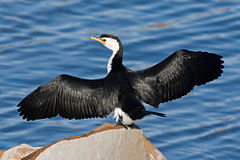Cormorants
| Cormorants and shags Temporal range: Late Cretaceous? – Recent |
|
|---|---|
 |
|
|
Little pied cormorant Microcarbo melanoleucos |
|
| Scientific classification | |
| Kingdom: | Animalia |
| Phylum: | Chordata |
| Class: | Aves |
| Order: | Suliformes |
| Family: |
Phalacrocoracidae Reichenbach, 1850 |
| Genus: |
Phalacrocorax (but see text) Brisson, 1760 |
| Species | |
|
3–43, see text |
|
| Synonyms | |
|
Australocorax Lambrecht, 1931 |
|
3–43, see text
Australocorax Lambrecht, 1931
Compsohalieus B. Brewer & Ridgway, 1884
Cormoranus Baillon, 1834
Dilophalieus Coues, 1903
Ecmeles Gistel, 1848
Euleucocarbo Voisin, 1973
Halietor Heine, 1860
Hydrocorax Vieillot, 1819 (non Brisson, 1760: preoccupied)
Hypoleucus Reichenbach, 1852
Leucocarbo Bonaparte, 1857
Microcarbo Bonaparte, 1856
Miocorax Lambrecht, 1933
Nannopterum Sharpe, 1899
Nesocarbo Voisin, 1973
Notocarbo Siegel-Causey, 1988
Pallasicarbo Coues, 1903
Paracorax Lambrecht, 1933
Poikilocarbo Boetticher, 1935
Pliocarbo Tugarinov, 1940
Stictocarbo Bonaparte, 1855
Viguacarbo Coues, 1903
(but see text)
Phalacrocoracidae is a family of some 40 species of aquatic birds commonly known as cormorants and shags. Several different classifications of the family have been proposed recently, and the number of genera is disputed. There is no consistent distinction between "cormorants" and "shags" as these appellations have been assigned to different species randomly.
Cormorants and shags are medium-to-large birds, with body weight in the range of 0.35–5 kilograms (0.77–11.02 lb) and wing span of 45–100 centimetres (18–39 in). The majority of species have dark feathers. The bill is long, thin and hooked. Their feet have webbing between all four toes. All species are fish-eaters, catching the prey by diving from the surface. They are excellent divers, and under water they propel themselves with their feet with help from their wings; some cormorant species have been found to dive as deep as 45 metres. They have relatively short wings due to their need for economical movement underwater, and consequently have the highest flight costs of any bird.
...
Wikipedia
